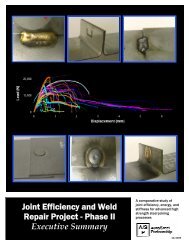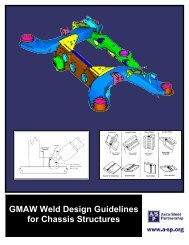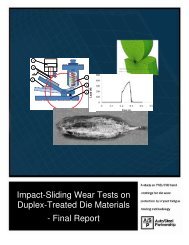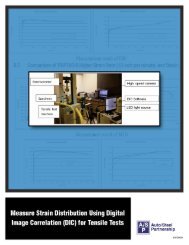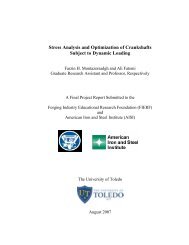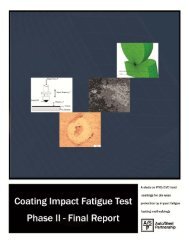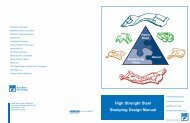Light Truck Frame Joint Stiffness Study Phase 1 Final Report
Light Truck Frame Joint Stiffness Study Phase 1 Final Report
Light Truck Frame Joint Stiffness Study Phase 1 Final Report
You also want an ePaper? Increase the reach of your titles
YUMPU automatically turns print PDFs into web optimized ePapers that Google loves.
APPENDIX A: ABSTRACTS<br />
characteristics and hotspot stresses of comparable T and V specimens. Addition of a loaded out-ofplane<br />
branch member of a T-joint increases the strength of the T-joint when the angle between the<br />
branches is low, and decreases it when the angle is large.<br />
10. 3D Simulations of Bolted Connections to Unstiffened Columns-I T-Stub Connections<br />
Sherbourne, A.N. and Bahaari, M.R.<br />
Journal of Constructional Steel Research, Dec. 1996<br />
The paper presents a finite element methodology in a three-dimensional (3D) framework to study<br />
numerically the stiffness and strength of the T-stub to unstiffened column flange bolted connection as<br />
part of a comprehensive research program to investigate the behavior of endplate bolted connections.<br />
In such connections, the axes of rotation of the T-stem and column flange are at right angles; the<br />
planes containing the tensile forces are also perpendicular to each other. Therefore, they are highly<br />
interactive spatially. The main objective here is to study the applicability of the model to such a<br />
connection, so that most of the important features that are not accessible to routine experiments, like<br />
prying action and gradual plasticity of components, can be monitored. ANSYS, version 4.4, a largescale<br />
general purpose finite element code is selected for this analysis. Initially, the simplest<br />
connection with the bolt groups in tension, which is a symmetric T-stub hanger with a single line of<br />
bolts paralleled on each side of the web, is considered. Then the T-stub connection to an unstiffened<br />
column flange is discussed.<br />
11. Criteria for the Fatigue Assessment of Hollow Structural Section Connections<br />
Van Wingerde, A.M.; Packer, J.A.; and Wardenier, J.<br />
Journal of Constructional Steel Research, 1995<br />
Discussion of fatigue design criteria is presented for connections between hollow structural sections,<br />
based on knowledge gained from an extensive study on the fatigue behavior of 90-T- and X-<br />
connections made of square hollow sections. After a general discussion of the various fatigue<br />
assessment method available the paper focuses on considerations behind the definition of the hot<br />
spot stress. On this basis, the current fatigue design guidelines are discussed. Based on knowledged<br />
gained from experiments and having identified the important fatigue design criteria, a hot spot<br />
definition is established, together with the outline of a proposal for future fatigue design guidelines of<br />
hollow section connections.<br />
12. <strong>Study</strong> on Residual Stress Relief of Welded Structural Steel <strong>Joint</strong>s<br />
Weng, C.C. and Chen, J.J.<br />
Journal of Materials in Civil Engineering; May 1993<br />
This paper presents the results obtained from the residual stress relief tests on 21 welded structural<br />
steel joints: 17 butt-welded, two tee, and two corner joint specimens. The A572 grade 50 structural<br />
steel plates of two different thicknesses, 15 and 32mm, were used. All specimens were welded by the<br />
submerged arc welding (SAW) process and were designed according to the prequalified welded joints<br />
specified by the American Welding Society. In this study, a controlled low-temperature stress-relief<br />
method was used for residual stress relief. The experimental result show that by using an appropriate<br />
combination of the heating temperature, heating distance, and cooling method, the original hightensile<br />
residual stresses near the weld of the joint can be reduced effectively. The residual stresses<br />
before and after the heat treatment were measured by using the blind hold-drilling method. A<br />
reduction of more than 50% of the original tensile residual stresses adjacent to the weld was<br />
observed.<br />
<strong>Report</strong>: A/SP-005-1 <strong>Light</strong> <strong>Truck</strong> <strong>Frame</strong> <strong>Joint</strong> <strong>Study</strong> 85



